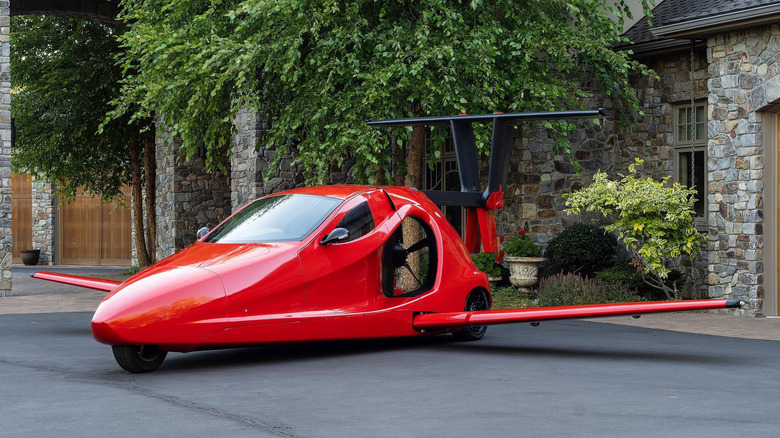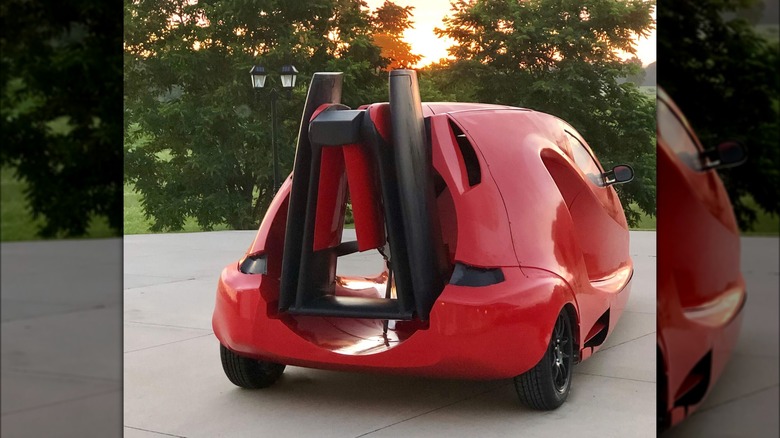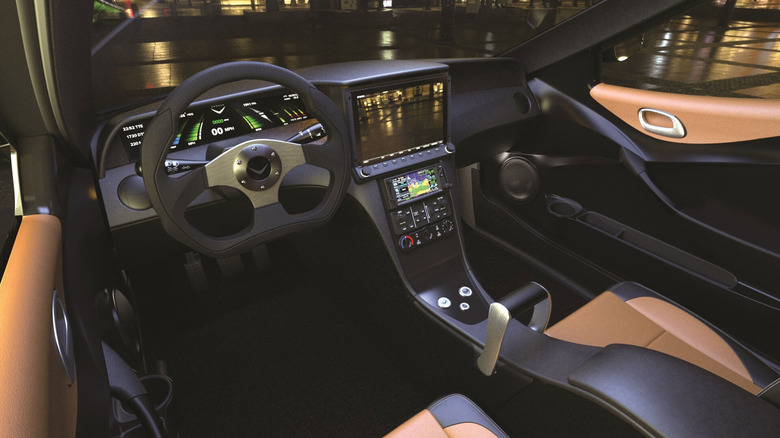Flying Into The Future: What You Need To Know About The Samson Switchblade Flying Car
If you're one of those high-tech consumers who bleed cutting edge, or you're just a pie-in-the-sky dreamer or automobile enthusiast still waiting around for flying cars that we've all collectively longed for since seeing George Jetson zip around in one (1962), well, such a thing is — at the very least — one step closer to becoming a reality. Finally.
The Samson Switchblade is a fully street-legal, three-wheeled "sports car" that can tool around the highways and byways of the world just like any other car. The one thing it can do that no other can is transform into a sky-worthy mode of transportation at the push of a button. Yes, a real transforming car. Finally!
The Switchblade (it even has a cool "Transformers" name!) isn't the first flying car we've ever seen, but it has been in development for well over a decade by some seriously credentialed personnel. On November 10, 2023, it completed its inaugural flight above Washington State, cruising for six minutes at an altitude of 500 feet. Mission accomplished, and where can we order one, right?
Not so fast! Before you grab your flying goggles, let's take a peek in the cockpit to see exactly who created the Switchblade, what's driving (and flying) it, and just how soon we can really expect to see this thing on the road (and in the sky).
Look, up in the sky!
For more than 25 years, Sam Bousfield was an architect by trade who always had a passion for the outdoors. The man also liked to tinker and invent, patenting several creations. One such inventive "side project" involved building a propeller-driven aircraft capable of breaking the sound barrier, which no one (including NASA) has ever accomplished.
So, Bousfield assembled a group of engineers from Boeing to work on the project, using resources at Boeing (after hours, of course). Between 2000 and 2003, the team built a prop plane with "proprietary body shapes" that Bousfield designed himself, one that caught the attention of the American Institute of Aeronautics and Astronautics (AIAA), the Swedish government, and well-known American aviator and adventurer, Steve Fossett.
Bousfield said Fossett would have used his design in his next great adventure. Unfortunately, Fossett died in September 2007 and never completed that quest. Bousfield remained resolute, knowing that some form of safe air travel would be the key to the transportation industry's future but realizing full well that driving to and fro would never die. Thus, he shifted his focus to designing a mode of mobility that merged the best of both worlds.
Enter the Switchblade, a vehicle that can simultaneously be registered at your local DMV as an automobile but also by the FAA as a plane. Under the "Experimental/Homebuilt" plane classification, it can be operated for non-commercial, recreational, and personal use, as well as research and development.
Switchblade can literally hightail it out of here
The two-passenger Switchblade is powered by a proprietary Samson 190-hp liquid-cooled three-cylinder engine equipped with Skybrid Technology, a hybrid driving system using regenerative braking, reverse thrusters, air brake assist, and other automated features to help with takeoffs and landings.
It can reportedly transform from a car into a plane in less than three minutes by swinging the wings tucked in the sides of the chassis/hull outwards while the tail pops open from the rear and extends into flight-ready mode. It has a maximum air speed of 200 mph (at 13,000 feet) with a cruising speed of 160. On the road, it can reach speeds of 125 mph or more.
With an estimated payload capacity of just 575 pounds (people, luggage, and fuel), the 36-gallon fuel tank provides a total range of 450 miles (~33 mpg ground / ~9.5 gph air), so keep that in mind if you're traveling (what verb do we use? Flive? Dry?) on a weeks-long trip to Bora Bora.
The Switchblade's total ground length is 16.8 feet, making it about as long as a full-size SUV; flight mode extends it to 20.2 feet. The average width of a car is 5.8 feet and the Switchblade is close at 6.0 feet. The top of the main body is 5.1 feet off the ground. Total wingspan reaches 26.9 feet with a wing load (the ratio of an aircraft's weight to its wing surface area) of 27 pounds per square foot.
Slide into something familiar -- at a stiff price
According to Bousfield, the Switchblade is made from a thermoplastic carbon fiber previously only used by Boeing and Airbus. They've developed a new process that cuts production time on certain parts from several hours to only 20 minutes. Moreover, the technique is non-toxic and fully recyclable.
The cockpit/cabin will look familiar to drivers (see above rendering), yet includes all the additional instrumentation and gauges needed to fly. When flight mode is engaged, the wheels automatically stop working, and the "steering wheel" is used to operate wing ailerons and tail elevators, while gas and brake pedals adjust the rudders.
The base model comes in two versions. The Visual Flight Rules (VFR) Kit lets pilots fly only during clear weather conditions and costs $170,000. The Instrument Flight Rules (IFR) Kit (at $195,000) allows flight through clouds and zero visibility conditions as long as it has adequate instrumentation (and approval). A "special" edition will be available starting at $330,000, and a "limited" edition at $770,000.
Aside from the driver's license (for an automobile or motorcycle, depending on local laws), a private pilot's license is required to fly, which could cost an additional $6,000 to $20,000.
Veteran test pilot Robert Moehle flew the Switchblade on its maiden flight and said it "handled great." Samson has already received over 2,300 reservations from 57 countries and every state in the U.S. But it's just the next step in the journey, because full-scale production is at least two more years away.


